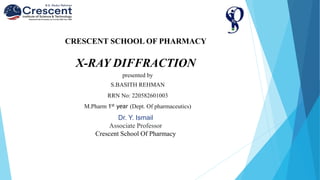
xrd rrn 03.pptx
- 1. CRESCENT SCHOOL OF PHARMACY X-RAY DIFFRACTION Dr. Y. Ismail Associate Professor Crescent School Of Pharmacy presented by S.BASITH REHMAN RRN No: 220582601003 M.Pharm 1st year (Dept. Of pharmaceutics)
- 2. Contents INTRODUCTION WHY X RAY AND WHY XRD PRINCIPLE BRAGG’S LAW INSTRUMENTATION POWDER X-RAY DIFFRACTION METHOD ROTATING CRYSTAL METHOD APPLICATIONS OF X-RAY DIFFRACTION ADVANTAGES REFERENCES
- 3. X-Ray Diffraction Introduction X-ray diffraction is used to obtain structural information about crystalline solids. Useful in biochemistry to solve the 3D structures of complex biomolecules. Bridge the gaps between physics, chemistry, and biology. X-ray diffraction is important for: Solid-state physics Biophysics Medical physics Chemistry and Biochemistry
- 4. What is X-ray? Beams of electromagnetic radiation smaller wavelength than visible light, higher energy more penetrative
- 5. Why XRD? Measure the average spacings between layers or rows of atoms Determine the orientation of a single crystal or grain Find the crystal structure of an unknown material Measure the size, shape and internal stress of small crystalline regions
- 6. PRINCIPLE In 1912, discovered that crystalline substances act as three- dimensional diffraction gratings for X-ray wavelengths similar to the spacing X-ray diffraction is now a common technique for the study of crystal structures and atomic spacing. X-ray diffraction is based on interference of monochromatic X- rays and a crystalline sample. Bragg's Law (nλ=2d sin θ). This law relates the wavelength of electromagnetic radiation to the diffraction angle and the lattice spacing in a crystalline sample.
- 8. INSTRUMENTATION X-ray diffractometers consist of three basic elements: an X-ray tube, a sample holder, and an X-ray detector. X-rays are generated in a cathode ray tube by heating a filament to produce electrons, accelerating the electrons toward a target by applying a voltage, and bombarding the target material with electrons. When electrons have sufficient energy to dislodge inner shell electrons of the target material, characteristic X-ray spectra are produced. Filtering, by foils or crystal mono chrometers, is required to produce monochromatic X-rays needed for diffraction. These X-rays are directed onto the sample. As the sample and detector are rotated, X-rays is recorded. A detector records and processes this X-ray signal and converts the signal to a count rate which is then output to a device such as a printer or computer monitor.
- 10. POWDER X-RAY DIFFRACTION METHOD In powder method, the crystal sample need not be taken in large quantity but as little as 1mg of the material is sufficient for the study. A is a source of X-rays which can be made monochromatic by a filter. Allow the X-ray beam to fall on the powdered specimen P through the slits S1 & S2. The function of these slits is to get a narrow pencil of X-rays
- 12. Applications of X-Ray Diffraction To Find structure to determine function of proteins Distinguish between different crystal structures with identical compositions Study crystal deformation and properties Study of rapid biological and chemical processes
- 14. References Wilson, K. S. (2018). An Introduction to X‐Ray Crystallography. ELS, 1–16. https://doi.org/10.1002/9780470015902.a0025432. Text book of instrumental methods of chemical analysis by chatwal pg -294 to 319.